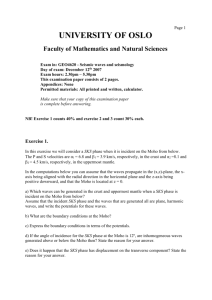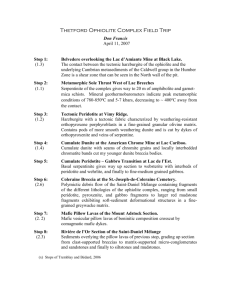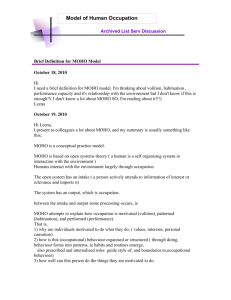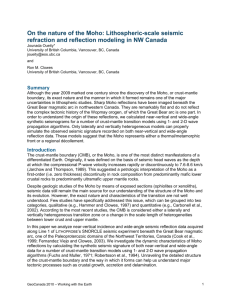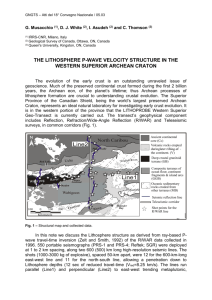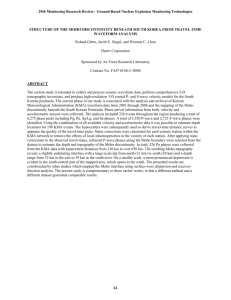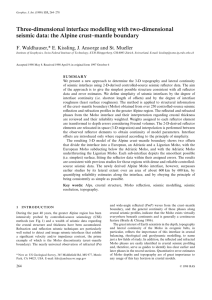Petrological nature of the oceanic Moho
advertisement
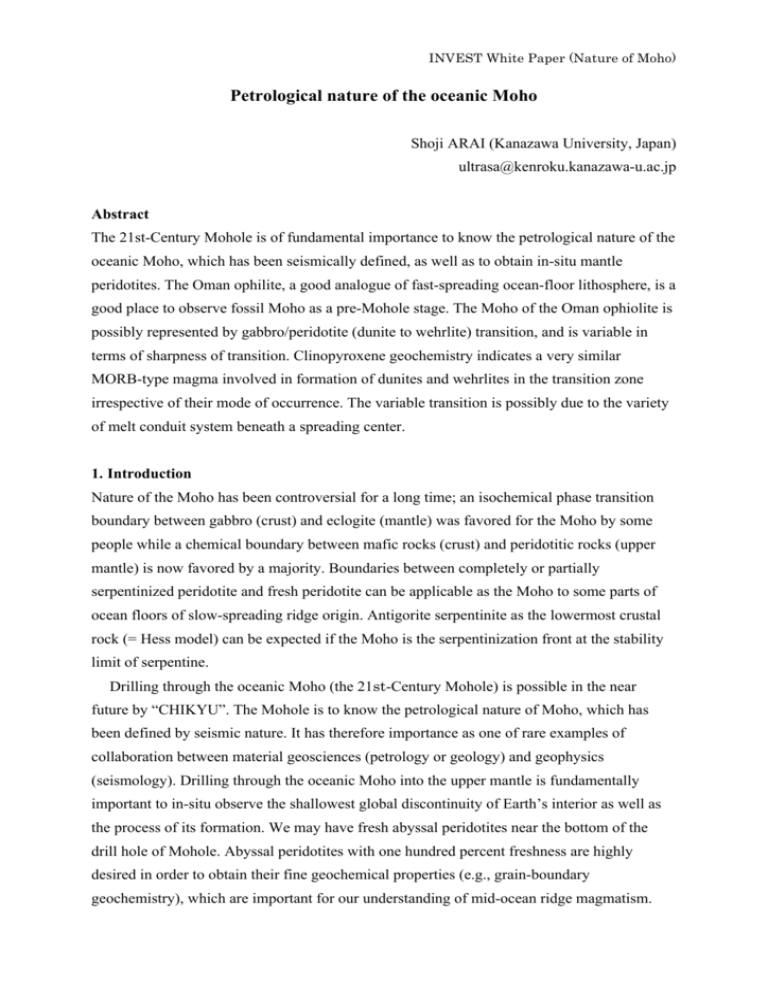
INVEST White Paper (Nature of Moho) Petrological nature of the oceanic Moho Shoji ARAI (Kanazawa University, Japan) ultrasa@kenroku.kanazawa-u.ac.jp Abstract The 21st-Century Mohole is of fundamental importance to know the petrological nature of the oceanic Moho, which has been seismically defined, as well as to obtain in-situ mantle peridotites. The Oman ophilite, a good analogue of fast-spreading ocean-floor lithosphere, is a good place to observe fossil Moho as a pre-Mohole stage. The Moho of the Oman ophiolite is possibly represented by gabbro/peridotite (dunite to wehrlite) transition, and is variable in terms of sharpness of transition. Clinopyroxene geochemistry indicates a very similar MORB-type magma involved in formation of dunites and wehrlites in the transition zone irrespective of their mode of occurrence. The variable transition is possibly due to the variety of melt conduit system beneath a spreading center. 1. Introduction Nature of the Moho has been controversial for a long time; an isochemical phase transition boundary between gabbro (crust) and eclogite (mantle) was favored for the Moho by some people while a chemical boundary between mafic rocks (crust) and peridotitic rocks (upper mantle) is now favored by a majority. Boundaries between completely or partially serpentinized peridotite and fresh peridotite can be applicable as the Moho to some parts of ocean floors of slow-spreading ridge origin. Antigorite serpentinite as the lowermost crustal rock (= Hess model) can be expected if the Moho is the serpentinization front at the stability limit of serpentine. Drilling through the oceanic Moho (the 21st-Century Mohole) is possible in the near future by “CHIKYU”. The Mohole is to know the petrological nature of Moho, which has been defined by seismic nature. It has therefore importance as one of rare examples of collaboration between material geosciences (petrology or geology) and geophysics (seismology). Drilling through the oceanic Moho into the upper mantle is fundamentally important to in-situ observe the shallowest global discontinuity of Earth’s interior as well as the process of its formation. We may have fresh abyssal peridotites near the bottom of the drill hole of Mohole. Abyssal peridotites with one hundred percent freshness are highly desired in order to obtain their fine geochemical properties (e.g., grain-boundary geochemistry), which are important for our understanding of mid-ocean ridge magmatism. INVEST White Paper (Nature of Moho) 2. Mohole on the fast-spread ocean floor We will conduct the (first) Mohole at a site on the Pacific Ocean, which is representative of the “ocean floor”. To prepare for as well as to complement the Mohole, we should conduct researches on ophiolites, where we can observe fossil Moho on land. The best target is the Oman ophiolite, where we can examine in detail the 2-D variation of the fossil Moho that cannot be checked even through the Mohole. The gabbro/peridotite (dunite) boundaries can be classified into two types, gabbor-in-dunite and dunite-in-gabbro, in the northern Oman ophiolite. In the former type, gabbros appear as intrusive bands or sills in dunite (or wehrlite) around the transition zone, and the transition is relatively gradual. In the latter type, the dunite (or wehrlite) (= “late-intrusive”) is intrusive to the crustal rocks (up to the base of sheeted dike complex), and the local gabbro/dunite transition is sharp. Some of the late-intrusive dunites (wehrlites) contain primary amphiboles. In addition, a dunite/wehrlite body with gabbroic bands (= within-crust dunite/wehrlite) was found within the layered gabbro, and possibly obscures the Moho. The distribution of the within-crust dunite may control the sharpness of the gabbro/peridotite transition (= Moho) (Figure 1). Figure 1. Variety of gabbro/peridotite transitions in the northern part of the Oman ophiolite. The transition is varied in terms of sharpness. The spatial distribution of rock species as well as mineral chemical variation suggests that INVEST White Paper (Nature of Moho) the Moho is a kind of peridotite/gabbro reaction zone. Dunites/wehrlites are possibly an interaction product, and the Moho likely starts to form during the interaction beneath the spreading center. They are equivalent to walls to melt conduits, and some of them are mobile as crystal mush and intruded into gabbros as late-intrusive rocks. It is noteworthy that chemical characteristics of clinopyroxene in dunites or wehrlites from the Moho transition zone of the northern Oman ophiolite are strikingly similar to each other irrespective of their mode of occurrence (Figure 2). This possibly indicates only one magma type (MORB-like) was necessary to form the apparently variable Moho transition zones (Figure 1). Figure 2. Trace-element characteristics of clinopyroxenes in dunites/wehrlites from the gabbro/peridotite transition zone in the northern Oman ophiolite. 3. Ultra-deep drilling on the OCC To examine the Hess-model Moho, the serpentinite/peridotite boundaries, I am proposing ultra-deep drilling (two to three kilometers deep) on one of the oceanic core complexes, e.g. Atlantis Bank, SWIR (another Mohole) , where deep-seated rocks are exposed on the ocean floor. We can in-situ observe the serpentinization front within the ultramafic (peridotitic) section, unraveling elemental mobility by aqueous fluids. We also know gabbro/peridotite (now serpentinized) boundaries even though they are not ordinary (or typical) ones. In addition, we can obtain fresh abyssal peridotites totally free of serpentinization through such a INVEST White Paper (Nature of Moho) Mohole. One of the obstacles in our detailed understanding of deep igneous activity beneath a mid-ocean ridge may be the lack in completely fresh abyssal peridotites available. We can do in-situ grain boundary geochemistry on such fresh peridotites in order to unravel melting/melt segragation/mantle metasomatic (if any) processes. 4. Concluding remarks The Mohole is the only way for us to in-situ observe Moho and to sample Moho-related rocks. This will provide us with the information on the petrological nature and process of formation of the oceanic Moho. We should conduct the first Mohole on the fast-spreading ocean floor. To prepare for the Mohole, the fossil Moho observed in the Oman ophiolite is a good target for a pseudo-Mohole.
